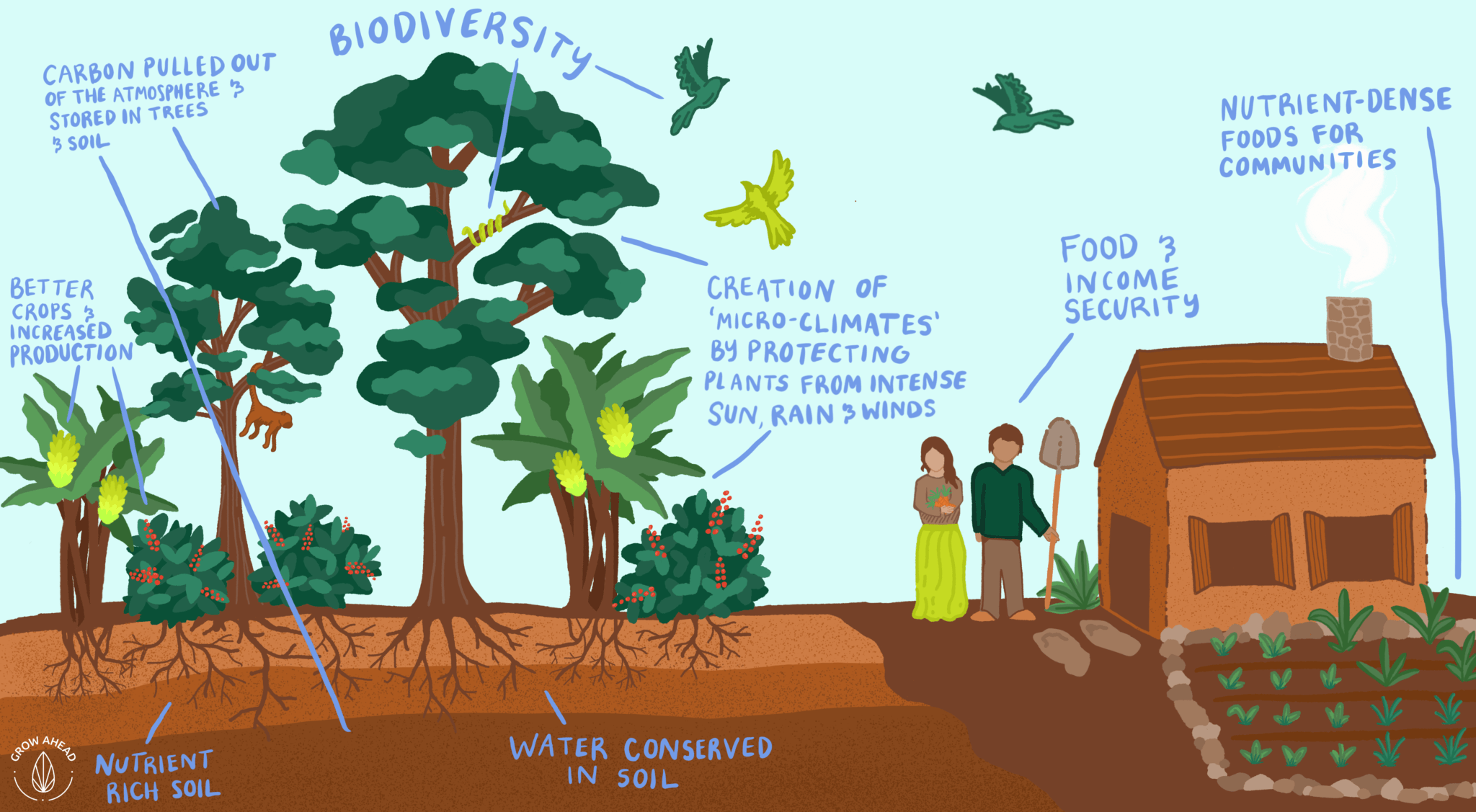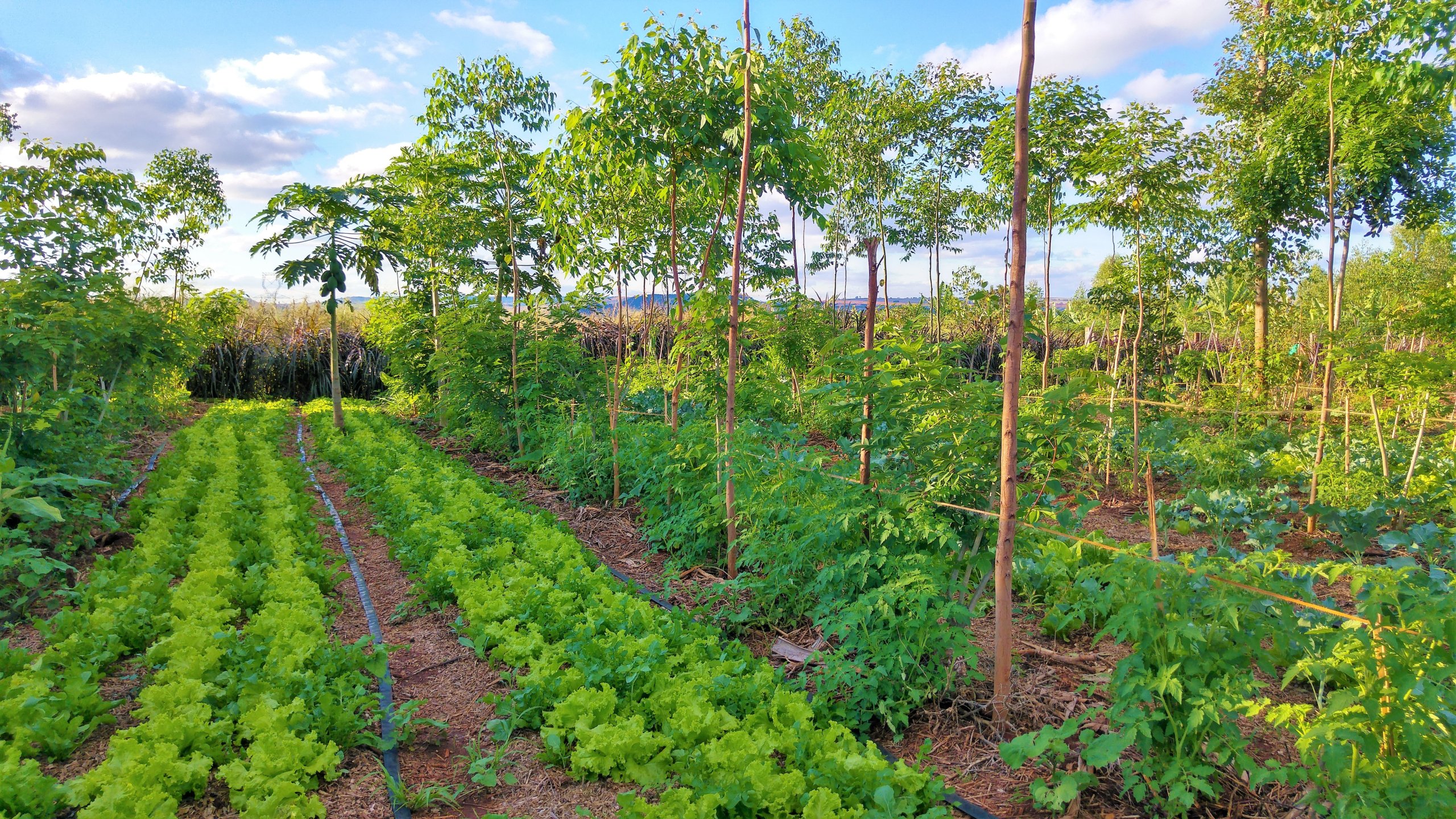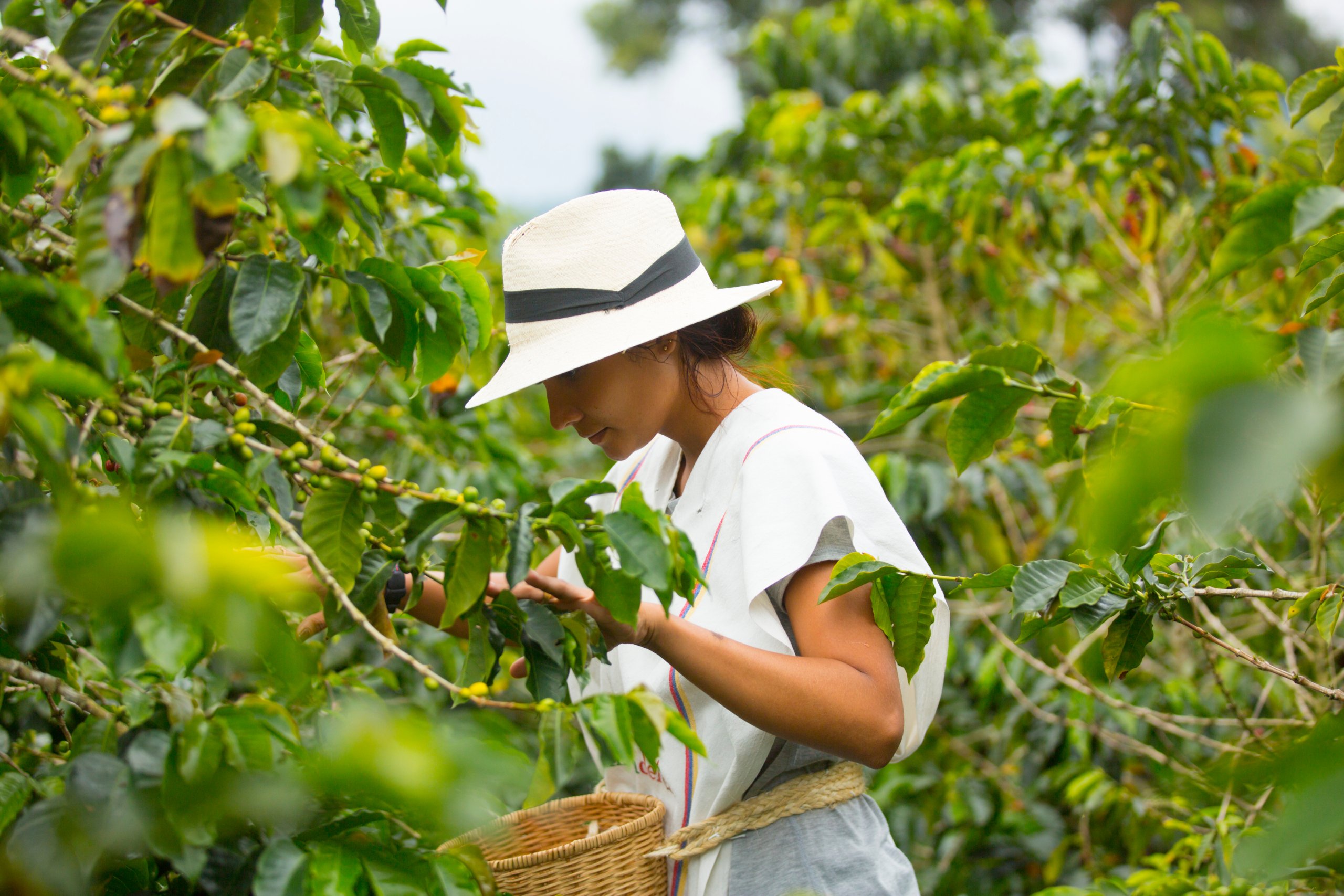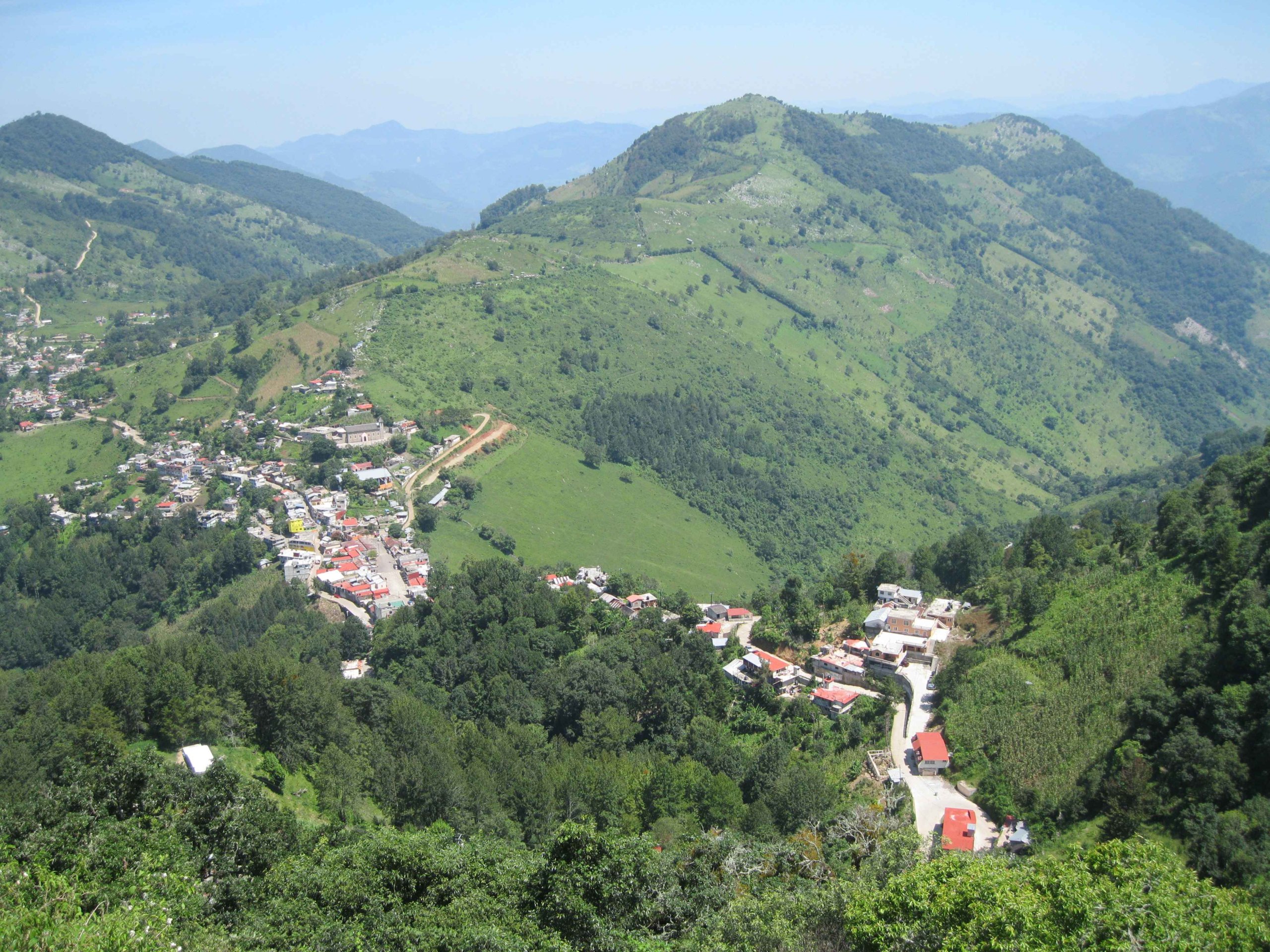 719
719  6 mins
6 mins Agroforestry solutions are a powerful answer to the problem of increasing CO2 emissions.
And they have surprising, unforeseen consequences.
Agroforestry – the evident solution
Agroforestry sounds technical, but it is very easy to understand. It simply means that farmers include trees, shrubs and livestock in the way that they farm.
It’s a traditional form of farming practised throughout the world. And although the term was coined in the 1970s, the practice actually dates back thousands of years.
Julia Gentner from Grow Ahead explains, “Indigenous communities have been doing agroforestry, growing food under the forest cover, forever. It’s not new…this isn’t some kind of new white led phenomenon, this is something that people have been doing for a long time.”
Julia is the Program Manager at Grow Ahead, a crowdfunding platform that works with small farmers in South America, Africa and Asia.
Grow Ahead helps farmers to plant trees and promote the benefits of Agroforestry solutions, particularly those who grow coffee and cacao.
Planting trees is one of the most elegant ways to pull carbon out of the atmosphere. Trees lock carbon into ecosystems.
It is simple, cheap, scalable and very effective.
And given that Agroforestry solutions are capable of stocking more than 600% more carbon than monoculture plantations, it is easy to understand why it is becoming such a compelling alternative to monoculture.

What is Agroforestry? Image courtesy of Grow Ahead
Funds for farmers
Because the farmers they work with are “historically under-resourced, with limited access to the capital needed to grow their organizations and invest in climate solutions”, Grow Ahead runs funding campaigns to help them to finance their projects.
These small-scale projects all help “restore water and nutrients to their soil, increase the production of food, and pull carbon out of the atmosphere.”
But there are other surprising benefits to the ancient practice of growing food under a forest canopy.
The projects give farmers “a way of managing the land so that plants like hardwood trees can grow alongside cash crops like cocoa and coffee. Folks are still able to sell their cash crops on national and international markets. But now they can also grow other biodiverse crops for family consumption or for sale on local markets”, says Julia.
Food forests
“As anyone who has ever been in a forest knows, there is an obvious advantage of farming under the cover of the forest. This kind of farming protects crops from winds and the intensity of the sun.
But there are many more advantages.
Food forests are also allowing farmers to naturally grow other nutrient-dense foods. The forest encourages biodiversity by housing diverse flora and fauna. It returns water and nutrients back to the soil in the land.
It’s a model that does more than tackling the climate crisis. It restores and protects biodiversity. Agroforestry contributes to the livelihoods of the people in the communities. It gives them access to food sovereignty. And it creates multiple avenues for revenue locally, nationally and internationally which creates income security.”

Agroforestry farm. Photo: Ana Cotrin / Shutterstock
A fundamentally radical act
Introducing Agroforestry as a best practice in farming comes with a “radical understanding” that the “climate crisis is rooted in colonialism and extractive capitalism.”
Agroforestry solutions directly contradict “colonial ways of farming where the land is ‘clear cut’ to make as much profit as possible as quickly as possible. That type of farming does not consider longevity, sustainability nor the health and livelihoods of farmworkers and people in those lands.” Julia explains.
Coffee is the second most valuable commodity exported in the world, right behind crude oil. Smallholders, farmers with farms of less than 5 hectares, grow 60% of the world’s coffee.
Yet 44% of these families are living below the international poverty line.
“Even though coffee is one of the world’s largest imports and exports, farmers live below the poverty line. And many suffer from seasonal hunger despite the fact they grow their own food. This is because of the way these industries are built. They are extractive and exploitative. The folks with whom we are working, farmers who are adopting agroforestry, are actually working to undo colonial models of farming.”
“These projects are going to be inherently political. Firstly because climate justice and the climate crisis is political. Secondly when you are working with communities whose experiences are direct lines from oppressive and exploitative systems, then you have to be political!”
Monoculture reforestation projects are not Agroforestry solutions
Although Agroforestry is about reforestation, not all reforestation is an Agroforestry solution.
Julia Gentner explains, “We see so many monoculture reforestation mega-projects. An organisation will get access to a large swath of land somewhere. They will go in and mono-culture hundreds of thousands or millions of trees. They will plant (fast-growing) trees like eucalyptus (or acacia) for example. This will bring a splashy ‘Trees Planted !” headline. The organization will check the box saying ‘We did it, we are done.’
But often it makes things worse for both the planet and for the people who were using that land in the first place.
These ‘environmental’ projects, even when they have the best intentions, become another form of neo-colonial project.”, reports Gentner.

Coffee harvest Photo: Fernando Alonso / Shutterstock
Recent research published in the journal Nature showed that such monoculture commercial plantations are ultimately not effective for sequestering carbon.
Indeed, the study’s main authors Simon L Lewis and Charlotte E. Wheeler found, “The regular harvesting and clearing of plantations releases stored CO2 back into the atmosphere every 10-20 years.” The authors wrote, “(Monoculture) plantations hold little more carbon, on average, than the land cleared to plant them… By contrast, natural forests continue to sequester carbon for many decades”.
Agroforestry solutions – the ripple effect.
The Pangoa Cooperative
To explain how a typical campaign is about more than just planting trees, Juila Gentner talks about a project that Grow Ahead recently completed. It was a “women-led reforestation project” done in collaboration with the Pangoa Cooperative.
The Pangoa Cooperative is located in Piura, Peru in the northern highlands bordering the Peruvian Amazon.
It’s a cooperative with a history of using “regenerative organic spaces’ to implement climate resiliency practices.
Since 1997, Pangoa has been led by Esperanza Dionisio Castillo. Doña Esperanza is a remarkable woman who became the Gerente (General Manager) of Pangoa in 1997.
By most accounts, she is probably the first woman to run a coffee cooperative in Peru and one of the rare women to do so in the male-dominated space of the coffee industry in Latin America.
Taking charge of Pangoa, Dionoso Castillo began the Women’s Committee in 1997. The Committee is an association that works with women in the community on topics such as income diversification and “self-esteem training”. In addition, the Committee also successfully created a local women’s market and works with women to enable them to take on leadership positions.
It’s work has been very influential in the community and today there are women in leadership positions across the cooperative.
A 100% women-led Agroforestry solution
Some of these women decided that they wanted to try reforesting on their land.
Having learned about the value of planting trees alongside coffee plants to create partial shade, they began to gather pine cones and seeds for different species of trees.
Meanwhile, they began to sell those seeds to their neighbours.
Interest grew. The women decided to launch a larger campaign. Through the women’s Committee, they began working with Grow Ahead to find funding for their vision.
Soon there were over 90 women involved in a project to reforest their family farms.
As the project gained momentum, they built nurseries to grow more trees. They also developed community education programs on the subject of income diversification for women.
After a few years, the trees began to bear fruit that folks either ate themselves or sold in the local community farmer’s markets.
The campaign is now fully funded and all of the seedlings have been planted.
The Cooperative continues to share updates with Grow Ahead.
To sum up, Julia reflected “it is an excellent example of how interesting this space is. Reforestation projects take a while. Because it takes 3 to 4 years for trees to be at any sort of maturity where you will be seeing a lot of the really great benefits. It’s a beautiful project that we have done together. And now that it’s over we will be getting updates and following up with them for years to come.”
A bridge to the future
With the projects that they fund, Grow Ahead is creating on-the-ground bridges to a fossil-fuel-free world. They are spreading awareness about what long-term climate resiliency looks like. And they are advocating for the undoing of colonial and neo-colonial ways of farming and trading.
This kind of work can only happen if collaboration is done from the ground up.

Agua Zarca, Lenca sacred land. Berta Cácereswas murdered in the struggle against the construction of a dam on Gualcarque River. Photo: Josue Jiry / Shutterstock
In closing, Julia Gentner highlighted one of their two current campaigns to illustrate the seriousness of this work for the communities with whom they work.
“Reforestation in Honduras” is a campaign to plant 40,000 trees to keep reforestation and agroforestry solutions moving forward in Marcala, La Paz, Honduras.
With this program, Grow Ahead is working with the COMSA cooperative and the Lenca people. This is the community of Berta Caceres. Caceres was the recipient of the prestigious Goldman Environmental Prize in 2015 for her fearless grassroots work defending the Gualcarque River, its surrounding environment and people.
One year later she was brutally murdered in her home for standing in opposition to the environmental destruction of her community.
The climate crisis, human rights and social justice are not separate subjects.
Agroforestry solutions are proving to be a sustainable answer to the problem of carbon emissions and organisations like Grow Ahead are valuable allies to the small farmers facing serious challenges in their attempts to develop and expand these practices.
Learn more about the Agroforestry solutions
Learn more about the Agroforestry solutions and programs at Grow Ahead on their website growahead.org and follow them on Instagram, Twitter, Facebook or LinkedIn
Feature photo credit: Stephane Bidouze / Shutterstock


 Teem Khan by Ana Brooks
Teem Khan by Ana Brooks https://unsplash.com/photos/e6ZlCzBnGWI
https://unsplash.com/photos/e6ZlCzBnGWI